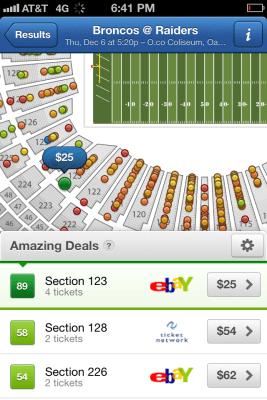SeatGeek, which aggregates tickets from resale sites like StubHub, just launched its first iPhone app, one that allows users to browse interactive maps as they try to find the best deals.
When SeatGeek raised funding back in August, the stated reason was to “build a really great mobile app.” Co-founder Russell D’Souza and Director of Communications Will Flaherty stopped by the TechCrunch office yesterday to show off the results of their work. The functionality should be pretty familiar to SeatGeek web users — you can search for tickets based on the performer, event, or venue. Then when you’ve found the event that you’re looking for, you can bring up a map showing where the different tickets would locate you, zoom in on any part of the map (usually surfacing more tickets as you do), then tap to buy.
I was particularly impressed by how much information SeatGeek is able to pack onto the iPhone screen. Despite the limited visual real estate, the team seems to have found an elegant way to lay out a full stadium map with lots of dots representing tickets, and basic ticket info below. (The tickets are sorted based on SeatGeek’s deal scores.) Flaherty said SeatGeek worked hard to pare away a lot of the features that aren’t essential on the phone, focusing on the search and map experience. If the site is a Swiss Army knife, then the iPhone app “cut out all the tools,” leaving “a really sharp blade,” he said.
D’Souza added that SeatGeek is the first smartphone ticketing app to include these kinds of interactive maps, rather than just static images of the venues. He argued that SeatGeek is “a technology company that happens to be in ticketing,” whereas its competitors “have the exact opposite mentality.” That also means we’ll see a number of rapid updates. (There’s also an Android app in development.) For example, D’Souza said he’s interested in the opportunities for integration with Apple’s PassBook.
Mobile has been growing dramatically for SeatGeek, D’Souza added. (The company already offered a mobile-optimized website, sans interactive maps.) It now makes up 25 percent of total traffic, and he said he wouldn’t be surprised if it accounted for the majority of SeatGeek’s traffic and revenue within 12 months.
In fact, given the mobile growth both at SeatGeek and the ticketing industry as a whole, the real surprise may be that the startup has waited so long to launch the app. One holdup — SeatGeek’s actual ticket purchases occur on other websites, so it would be a bit annoying for users if they got a great mobile experience on SeatGeek, only to be a passed off onto a hard-to-navigate site to complete the deal. Now that many of the company’s partners have built mobile-optimized sites themselves, it made more sense for SeatGeek to make the leap. (You can also filter searches so that they’re limited to sites that are designed for mobile checkout.)
SeatGeek launched at the TechCrunch50 conference in 2009 and recently said that it has turned profitable. You can download the iPhone app here.
